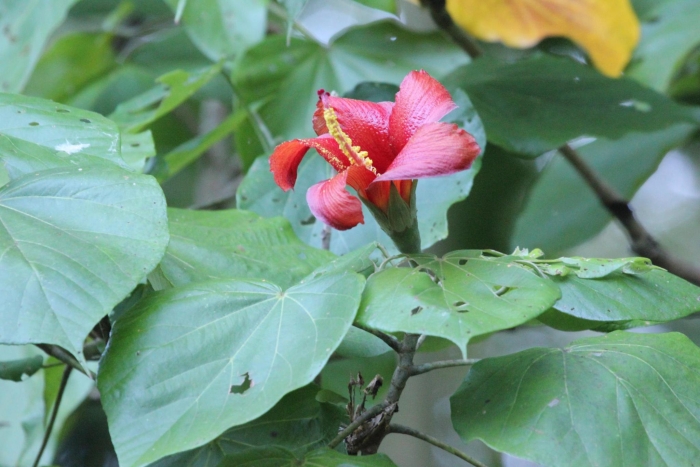Blue Mahoe
(Talipariti elatum)
Blue Mahoe (Talipariti elatum)
/
/

© Abby Darrah
CC BY 4.0
Image By:
© Abby Darrah
Recorded By:
Copyright:
CC BY 4.0
Copyright Notice:
Photo by: © Abby Darrah | License Type: CC BY 4.0 | License URL: http://creativecommons.org/licenses/by/4.0/ | Uploader: adarrah | Publisher: iNaturalist |

























Estimated Native Range
Summary
Talipariti elatum, commonly known as Blue Mahoe, is a deciduous to semi-deciduous tree native to the moist lowland forests and montane rainforests of the Caribbean, specifically Cuba, Jamaica, the US Virgin Islands, and Puerto Rico. It can grow up to 66 feet (20 meters) in height, with a typical width of 20 to 35 feet (6 to 10.7 meters). The Blue Mahoe is characterized by its broad, green leaves and striking hibiscus-like flowers that bloom throughout the year, changing color from yellow to orange and finally to crimson as they age. The flowers are quite showy, attracting pollinators and adding ornamental value. The tree’s wood is notable for its beautiful blue-green streaks and is highly valued for cabinet making, decorative objects, and musical instruments.
In cultivation, Blue Mahoe is appreciated for its rapid growth, tolerance to various soil types, and its ability to thrive in full sun to partial shade conditions. It requires moderate watering and well-drained soils. This tree is often used in reforestation projects due to its fast growth and adaptability. It is also the national tree of Jamaica, symbolizing the island’s beauty and resilience. While it is not commonly used in small gardens due to its size, it is an excellent choice for larger landscapes, parks, and as a street tree in tropical and subtropical regions. Gardeners should be aware that it can be susceptible to pests like borers and caterpillars, and diseases such as leaf spot.CC BY-SA 4.0
In cultivation, Blue Mahoe is appreciated for its rapid growth, tolerance to various soil types, and its ability to thrive in full sun to partial shade conditions. It requires moderate watering and well-drained soils. This tree is often used in reforestation projects due to its fast growth and adaptability. It is also the national tree of Jamaica, symbolizing the island’s beauty and resilience. While it is not commonly used in small gardens due to its size, it is an excellent choice for larger landscapes, parks, and as a street tree in tropical and subtropical regions. Gardeners should be aware that it can be susceptible to pests like borers and caterpillars, and diseases such as leaf spot.CC BY-SA 4.0
Plant Description
- Plant Type: Tree
- Height: 20-65 feet
- Width: 30-50 feet
- Growth Rate: Moderate
- Flower Color: Red, Yellow
- Flowering Season: Spring, Summer
- Leaf Retention: Evergreen
Growth Requirements
- Sun: Full Sun, Part Shade
- Water: Medium
- Drainage: Medium, Fast
Common Uses
Low Maintenance, Showy Flowers, Street Planting
Natural Habitat
Moist lowland forests and montane rainforests
Other Names
Common Names: Mahoe, Cuba Bark, Dmeajagua, Emajagua Excelsa, Mahaut, Majagua, Cuban Bast, Majagua Azul
Scientific Names: , Talipariti elatum, Hibiscus elatus, Hibiscus tiliaceus subsp. elatus, Hibiscus tiliaceus var. elatus, Pariti elatum, Pariti elatum, Pariti elatum var. macrocarpum, Pariti tiliaceum var. elatum, Paritium elatum
GBIF Accepted Name: